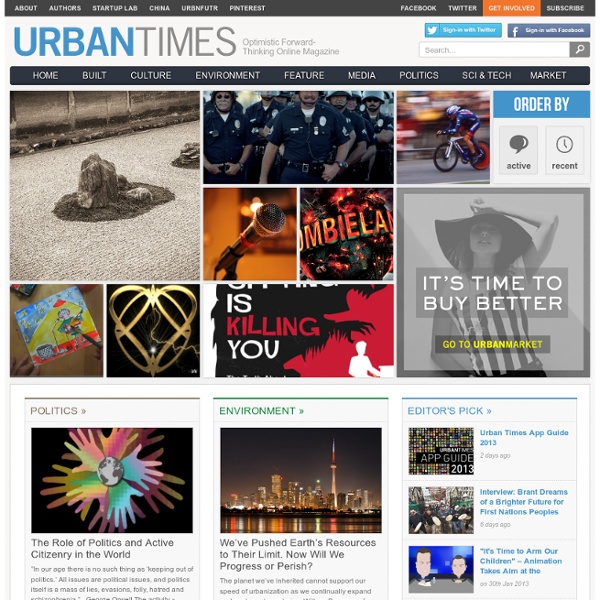



WHAT THE FUCK HAVE YOU DONE? Archinect | Connecting Architects Since 1997 Louis Proyect: The Unrepentant Marxist Parlour | women, architecture, equity. Exiting The Anthropocene and Entering The Symbiocene. | glennaalbrecht Exiting The Anthropocene It has been proposed that humans are now living within a period of the Earth’s history appropriately named ‘The Anthropocene’ (Crutzen and Stoermer 2000). The name is derived from the observed human influence and indeed dominance of all climatic, biophysical and evolutionary processes occurring at a planetary scale. Gone is the relative stability and predictability of the past 12,000 years as the established patterns and regularity of Holocene phenology begin to fall into chaos. In the Anthropocene, the so-called ‘new normal’, or what I prefer to conceptualise as ‘the new abnormal’, life will be characterised by uncertainty, unpredictability, genuine chaos and relentless change. We need to get rid of the foundations of the concept of the Anthropocene before it covers many more decades of history of Earth. Dominance by powerful vested interests has also become characteristic of what is called democracy. Entering The Symbiocene Imagining The Symbiocene Sumbiocracy
Design Observer Panarchy Panarchy What is Panarchy? Panarchy is a conceptual framework to account for the dual, and seemingly contradictory, characteristics of all complex systems – stability and change. It is the study of how economic growth and human development depend on ecosystems and institutions, and how they interact. It is an integrative framework, bringing together ecological, economic and social models of change and stability, to account for the complex interactions among both these different areas, and different scale levels (see Scale Levels). Panarchy’s focus is on management of regional ecosystems, defined in terms of catchments, but it deals with the impact of lower, smaller, faster changing scale levels, as well as the larger, slower supra-regional and global levels. The development of the panarchy framework evolved out of experiences where “expert” attempts to manage regional ecosystems often resulted in considerable degradation of those ecosystems (Gunderson and Holling, 2002). Adaptive Cycles
IAKC Home - InteriorArchitectureCommittee The American Institute of Architects Board of Directors awarded the 2013 AIA Architecture Firm Award to Tod Williams Billie Tsien Architects, who blend exquisite care for detail with subtle, reverent architecture that's both timeless in its abstracted, meditative forms and materially specific to context and place. The AIA Architecture Firm Award, given annually, is the highest honor the AIA bestows on an architecture firm, and recognizes a practice that has consistently produced distinguished architecture for at least 10 years… Tod Williams Billie Tsien Architects respect the Modernist legacy of orthogonal, functional minimalism, but place it in a wider context of earthen, material richness. Read the full interview with Billie Tsien. Read our previous interviews with Lauren Rottet / Clive Wilkinson / Todd DeGarmo / Rand Elliot
Darwin's Wedge & Dumb Competition | Errors We Live By “Competition creates efficiency,” is preached as if it were a law of nature. But nature itself teaches a different lesson. Biological competition can create foolish costs, and collective doom. “Darwin’s Wedge” shows why and reminds us of the point of being human. Our competitions, and the myopic logic of free markets, needn’t be dumb as trees. “Tree trunks are standing monuments to futile competition” says Richard Dawkins. What can market lovers learn from nature's competitions? A $62 billion monument to “futile competition” exists in healthcare. Robert Frank coined “Darwin’s Wedge” to describe situations where individual incentives diverge from collective goals (sometimes even risking collective doom). Competition’s benefits arise from the constraints it creates. Illustration by Julia Suits, The New Yorker Cartoonist & author of The Extraordinary Catalog of Peculiar Inventions.
Interior Design Educators Council | IDEC A New Economic System for a World in Rapid Disintegration (Photo: Antoine Collet; Edited: LW / TO) We live in ominously dangerous times. The world capitalist system -- having fueled colonialism, imperialism and the constant intensification of labor power exploitation for roughly 500 years -- now threatens the planet with an ecological collapse of unprecedented proportions. Unsustainable resource exploitation, water pollution (the transformation of lakes, rivers and oceans into garbage dumps) and massive economic inequality are at the root of the possibly irreversible collapse of industrial civilization. Meanwhile, however, too many of us remain caught up in abstract and ahistorical predictions of collapse that fail to offer an alternative realistic vision of a future socio-economic order. Nonetheless, the catastrophic scenario sketched out behind the operations of global capitalism does not merely represent the other side of a wild socio-economic system bent on constant and abstract growth in pursuit of ever greater rates of profit.